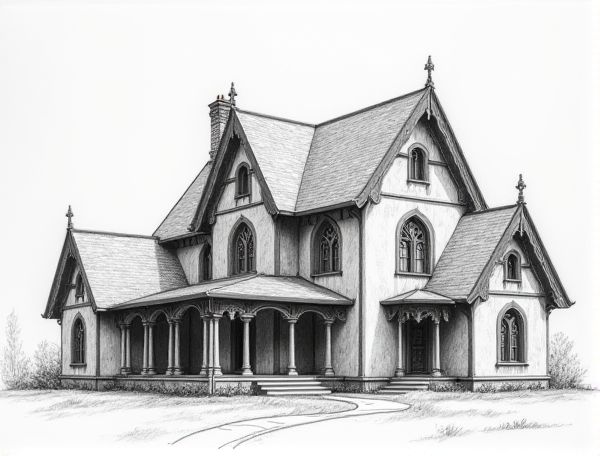
Photo illustration: Gothic Revival home design with tracery windows
Gothic Revival home design features intricate tracery windows that create a dramatic interplay of light and shadow, adding a timeless elegance to your living space. Discover how these architectural details can transform your home's aesthetic by reading more in the article.
Introduction to Gothic Revival Home Design
Gothic Revival home design features pointed arches, steeply pitched roofs, and intricate wooden trim that evokes medieval European architecture. Your home can showcase dramatic windows with tracery and decorative elements like finials and quatrefoils for an authentic Gothic aesthetic. Embracing this style adds historic charm and a sense of grandeur to modern living spaces.
Key Features of Gothic Revival Architecture
Gothic Revival architecture showcases pointed arches, ribbed vaults, and intricate tracery that create a dramatic and historic ambiance in your home design. Tall, narrow windows with stained glass, steeply pitched roofs, and ornate stone or wood carvings emphasize verticality and elaborate detail. Incorporating these key features into your space evokes a timeless elegance inspired by medieval Gothic cathedrals.
Origins and Historical Context
Home design traces back to ancient civilizations such as Mesopotamia and Egypt, where architectural styles reflected social hierarchy and environmental adaptation. The evolution of residential architecture continued through Greek and Roman periods, emphasizing symmetry, proportion, and the integration of indoor and outdoor spaces. Throughout history, cultural influences and technological advancements shaped home design, laying the foundational principles for modern architectural styles.
The Role of Tracery Windows in Gothic Revival Homes
Tracery windows in Gothic Revival homes are essential architectural features characterized by intricate stone or wood patterns that enhance natural light while emphasizing verticality and ornate detail. These windows not only support the historical authenticity of Gothic Revival design but also contribute to the overall aesthetic by creating dramatic shadows and a sense of grandeur within interior spaces.
Types of Tracery Patterns in Residential Design
Tracery patterns in residential design often include geometric, curvilinear, and flamboyant styles, each enhancing windows and facades with distinct artistic details. Geometric tracery features linear and symmetrical shapes, curvilinear incorporates flowing, curved lines, and flamboyant tracery showcases intricate flame-like motifs to add visual complexity.
Materials Commonly Used for Tracery Windows
Tracery windows are often crafted using durable, aesthetically pleasing materials such as sandstone, limestone, and marble, which provide both structural integrity and intricate detailing. Lead came is commonly employed to join stained glass pieces, enhancing the window's ornamental design and light diffusion. Wood and metal frames, particularly wrought iron, support the tracery structure, ensuring long-lasting stability and resistance to weathering.
Interior Impact of Tracery Windows
Tracery windows create a striking visual impact by introducing intricate patterns of light and shadow that enhance the ambiance of interior spaces. Their detailed stone or wood frameworks serve as focal points, elevating the aesthetic appeal and complementing Gothic or traditional architectural styles within a home.
Blending Gothic Revival with Modern Elements
Blending Gothic Revival with modern elements creates a unique home design that fuses ornate pointed arches and ribbed vaults with sleek lines and minimalist materials. Integrating stained glass windows alongside industrial metals and glass enhances natural light while preserving historical character. This approach balances medieval architectural grandeur with contemporary functionality for a timeless living space.
Tips for Restoring or Installing Tracery Windows
Use epoxy resin for repairing damaged wooden tracery frames, ensuring a seamless finish that preserves original details and enhances durability. Choose lead came or zinc came for installing new stained glass panels, maintaining structural integrity while complementing the historic character of tracery windows.
Inspiring Gothic Revival Homes with Iconic Window Designs
Gothic Revival homes feature striking pointed arches and intricate tracery in their window designs, creating a dramatic interplay of light and shadow that enhances the architectural character. Tall, narrow lancet windows often incorporate stained glass with medieval motifs, adding vibrant color and historical ambiance to interiors. These iconic window elements not only define the style's romantic allure but also optimize natural light while maintaining privacy within Gothic-inspired residences.
 homedesy.com
homedesy.com